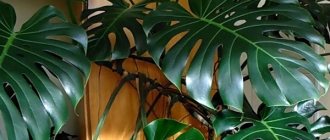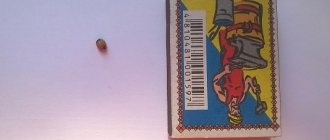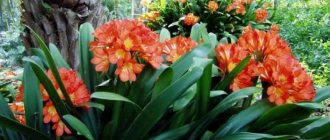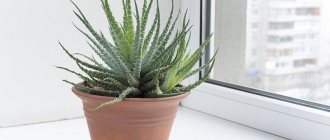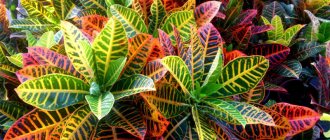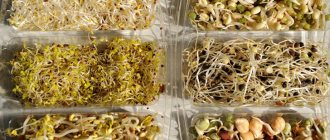Growing exotics
Many people believe that shade-tolerant and shade-loving indoor flowers are one and the same.
In fact, these people are deeply mistaken. The difference in the characteristic features of such plants is obvious. Shade-tolerant plants prefer to grow in diffused light and thrive in partial shade. These flowers can be used to decorate offices, hallways, and dark rooms.
Shade-loving plants are decorative deciduous plants, mostly non-flowering. They are ideal for placement on northern window sills. If you still want the room on the north side to be decorated with flowering plants, you need to select shade-tolerant species.
Not every apartment will look cozy without flowers. But not everyone has enough time to provide proper care for their capricious green “tenants.” Therefore, gardeners are increasingly giving preference to shade-loving and unpretentious indoor plants. This is explained by the fact that the latter do not require additional care, so growing an exotic flower even in a dark room is very simple.
Soil and fertilizers
It just so happens in nature that shade-loving flowers are deprived of sunlight, but still they must receive all the beneficial substances in abundance. Therefore, the key to plant health is properly selected soil. It is from this that the flowers will receive everything they need for good growth and proper development. For shade-tolerant plants, natural fertile soil is the best option. The peat composition of the soil is not suitable for this case.
Carnivorous plants: their names, types and nutrition
Like all indoor flowers, shade-loving flowers need regular feeding. You can purchase it in specialized stores. You should buy fertilizer for indoor flowers. Dilute it according to the instructions indicated on the container. You need to feed only after abundant watering, try to do it carefully and not get it on the leaves of the flower.
When replanting flowers, it is necessary to select pots of appropriate size. It is not advisable to transplant a large flower into a small pot. In such a container, the overgrown flower will not have enough nutrition and moisture. Shade-loving plants cannot tolerate frequent transplants, so the pot must be immediately selected according to size.
Drainage and watering
The lack of sunlight for these plants must be compensated by suitable soil, fertilizing, drainage and regular proper watering. Shade-loving plants consume large amounts of moisture. They do not tolerate drought well, but even with high humidity, their roots can be susceptible to rotting. Therefore, when watering, you should determine the golden mean. Pots for these flowers should be purchased with holes in the bottom. But as a rule, the capacity of such a pot is not enough to store water for a shade-loving plant, so it is recommended to immediately replace the small tray with a larger one, where water will accumulate in abundance, and the plant will be able to consume moisture through the roots in the amount in which it is needed at the moment . In addition, the water in the tray will prevent drought in the soil of the pot.
Nuances of care
Shade-loving animals do not require special painstaking care
But it should be remembered that they are distinguished by rich green mass, which also needs to be given attention
Catchment plant, its description and features
As a rule, most of these plants have large and massive leaves. From time to time they need to be wiped with a damp cloth to remove dust. This procedure can be carried out once a week - this will allow the plant to breathe freely. In addition, flowers love moisture, so sometimes they can be sprayed with water from a spray bottle.
Plants that tolerate light shade and require lighting
- Brunfelsia (Brunfelsia) - brunfelsia prefers diffuse shade, at the same time it is noted that in open ground culture in a humid climate some species (B. pauciflora) develop well in the sun and in partial shade;
- Calathea - although calatheas are not as fastidious as arrowroots in relation to air humidity, they also prefer high humidity. Plants also do not tolerate temperature changes well. The ideal placement for kalatyas is a closed flower window;
- Cordyline - bright place, partial shade, does not tolerate direct sunlight. Many people consider cordyline, like dracaena, to be a shade-loving plant, but in fact, in a dark place it will lag in growth and become smaller. Intense light is needed for good growth and development. Variegated forms require more lighting than forms with green leaves. If there is enough light in summer, then in winter the cordilines should be moved closer to the window, since in winter there is usually always not enough light;
- Privet (Ligustrum) - Ligustrum will adapt to any conditions. Ligustrum loves the sun, but grows well in partial shade;
- Arrowroot (Maranta) - leaves have the ability to change their direction: under favorable conditions, the leaf blades are located almost horizontally, and when there is a lack of lighting or under other unfavorable conditions, they rise up and fold together;
- Monstera (Monstera) - does not tolerate direct sunlight. Many people believe that Monstera is shade-loving and place it in the darkest corner - this is not correct. In fact, Monstera is shade-tolerant, and the best place for it is where there is bright but diffused light or light partial shade.
- Large-leaved Podocarp , or Large-Leafed Podocarpus (Podocarpus macrophyllus) - can withstand shade, although, like any normal plant, it prefers good lighting;
- Peperomia - species of peperomia with dark green leaves grow in light partial shade, variegated species are more light-loving. In winter, good lighting is required, otherwise the leaves begin to shrink and lose color, so by winter, move the peperomia closer to the window;
- Pittosporum - can tolerate shade, but in this case it blooms worse;
- Syngonium - species of syngonium with dark green leaves tolerate light partial shade, variegated varieties are more light-loving;
- Capitate yew (Cephalotaxus) is an evergreen columnar shrub, strictly vertical, little branched, with very densely spaced branches, more funnel-shaped or rounded-barrel-shaped with age, reminiscent of a dark green, columnar yew with coarse scales; grows slowly;
- Fatsia (Fatsia) - tolerates partial shade, requires good lighting in winter;
- Philodendron (Philodendron) - representatives of the genus are climbing, creeping vines, with woody or semi-herbaceous branches and shoots, as well as with long aerial roots;
- Chamedorea , or “bamboo palm” (Chamaedorea) - prefers bright, diffused light, tolerates some shade. Can tolerate a small amount of direct sunlight; in summer the palm tree is shaded from it;
- Cissus (Cissus) - Antarctic and multi-colored cissus do not tolerate direct sun and can grow in a shaded place, but a place near an eastern or western window is especially suitable for them;
- Eucharis (Eucharis) - during the flowering period, is a beautiful solitary plant that can decorate shelving in the office, bookshelves in the study, bedside table, coffee table and even the bathroom (of course, with a window). During periods of dormancy, its lush, dark green leaves make a wonderful backdrop for a potted plant arrangement. In the winter garden, it is better to place eucharis under the canopy of large plants;
- Ficus (Ficus) - stable in indoor conditions, suitable for residential and office premises, winter gardens. Ficus trees are very beautiful in the interior. Climbing and creeping are spectacular in hanging ceramic vases. They grow quickly and are relatively undemanding to light.
Indoor plants growing in poor lighting conditions.
© easyfeeding I would be glad if you share your experience and observations about those plants that could be grown in shaded areas of apartments.
Heat-loving plants for the room
Few people know that there is a wide variety of undemanding plants that will grow without difficulty even in unsuitable conditions and without constant sunlight. It is enough to organize their life activity by watering them a couple of times a week and feeding them with mineral fertilizers from time to time.
So, what undemanding and heat-loving plants can you plant in your summer cottage? We offer you a couple of great options.
Flowering plants. Do you want to become the owner of a beautiful, colorful, flowering plant? It turns out that not everyone needs a lot of sunlight. There are species that can grow even in dark conditions and drafts, for example:
Women's happiness (spathiphyllum). Perhaps the most adored flower of many women. It grows well and does not require complex care. Even if you put it to grow on the north side of the window, its leaves will still acquire a bright shade and take on an elongated shape. Women's happiness only requires compliance with one condition - constant moisturizing and spraying a couple of times a month.
Women's happiness (spathiphyllum)
Gardenia. What do you know about pride? This plant is a true find for many gardeners. At low humidity and low temperature, it will delight you with its rainbow, lush flowering. The only thing that needs to be done is to always remove wilted buds.
Gardenia.
Saintpaulia. In our country, this is what they call violet - a small flower that thrives in partial shade and does not need frequent watering or heavy moisture. In summer it will grow at a fairly high temperature - +25 degrees, and in winter it will not freeze even at +15 degrees.
Saintpaulia.
Vriesia. This exotic, unique and unusual plant impresses with its flowering, which, with proper care, will delight your eye for a long period of time.
But Vriesia will only grow when there is water in the plant’s rosette, so your attention will be needed
Vriesia.
Ampelous plants. Do you need to decorate your walls? Furniture to add a touch of grace to the room? Then this ampelous type of plant is just for you. They are advised to be grown in flowerpots, pots, flowerpots and baskets. Which hanging plants are undemanding and can grow even in the shade? Let's look at a few options:
Ivy. This is perhaps the most popular plant, which is very popular among gardeners. It can withstand any temperature changes and can grow even in constant shade. Ivy does not tolerate direct sunlight and reacts poorly to sudden changes in temperature.
Ivy
Green-leaved syngonium. Quite an unusual, but very beautiful plant. It is distinguished by bright, green leaves that, like a vine, stretch upward. After a couple of months of cultivation, you will see a solid green cascade that will decorate your home very effectively.
Green-leaved syngonium.
Peperomia. A beautiful flower that grows on a tree in the wild. Requires simple care - fertile soil, systematic watering, summer spraying and constant exposure to ultraviolet rays. In winter, when the amount of sun is limited, additional artificial lighting can be used for peperomia.
Peperomia.
Tradescantia. The plant grows well even in very dark corners of your home, and is easy to care for. The only thing it cannot survive without is a sufficient amount of moisture.
Tradescantia.
Palm plants. Do you like palm trees? If yes, then you will be happy to know that almost all types of palm trees can be grown in the shade. Which ones can be planted indoors?
Ficus. The most popular plant among gardeners. Its advantage is its attractive appearance, fast growth and not being whimsical in a large amount of light. Ficus trees are often planted in office buildings, kindergartens, service buildings, etc.
Ficus.
Rapis. This is not only a beautiful, original indoor flower, but also a plant that is beneficial for human health. It perfectly purifies the air and destroys harmful substances. For its normal functioning, only a small amount of diffused light is needed, which can be obtained by moving the pot of rapis away from the window, generous watering and fertilizer.
Rapis.
Dracaena. Although the plant belongs to the palm species, it has a tree-like form. Does not like drought, lack of watering and lack of light.
Dracaena.
So, there are shade-loving and unpretentious indoor plants that you can easily grow in your home. We hope that you will be able to fill your home with beautiful, bright flowers with your own hands.
Good luck with your choice!!!
Which indoor plants are shade-loving?
Plants classified as shade-tolerant have different reactions to sunlight. Some prefer diffused light; they droop, fade and may die when exposed to bright sunlight. Others need direct sunlight every day, but in doses.
The article presents shade-tolerant indoor plants with names and photos.
Almost all species have wide or long but thin leaves, which allow them to absorb more light, and these plants also consume more nutrients contained in the soil. By choosing the right varieties of indoor plants, you can beautifully decorate the interior with limited lighting.
Shade-tolerant indoor plants (names and photos are presented below):
| Name | a brief description of |
| Anthurium | Loves shade and partial shade, blooms with small blue flowers. The growing temperature should not be lower than +21˚С. |
| Clivia | It does not require special care: diffused light and regular watering are sufficient. |
| Vriesia | The plant with large red showy flowers grows in partial shade, but requires constant soil moisture. |
| Uzumbara violet | Valued by flower growers for continuous and abundant flowering and ease of care at home. |
| Sansevieria or mother-in-law's tongue | The inflorescences are white or yellowish, appear on spear-shaped stems, and the leaves curl neatly at night. |
| Fern | They feel good even in a dark hallway. |
| Ficus | There are dwarf and ampelous species that do not require much sunlight. |
| Schefflera | Needs high humidity. |
| Dracaena | A full-fledged plant grows with good care. |
| Cordilina | Can be grown in a window facing north. |
| Monstera | Needs abundant watering and spraying. |
| Palm | Grows in partial shade. |
| Philodendron climbing | The plant requires strong shade. Grows well in containers both indoors and outdoors. |
| Tradescantia | Needs partial shade. |
| Cissus | Can be grown in semi-dark and dark rooms. |
| Coleus | The plant is valued for its beautiful leaf colors: lemon yellow, hot pink, light green and chocolate brown. |
| Dieffenbachia | The popular houseplant can grow up to 1m tall and has a unique leaf pattern with yellow and green spots that appear randomly scattered throughout the foliage. |
| Caladium | A tropical plant with large and showy red or pink-green heart-shaped leaves. |
| Miltonia sunset | Herbaceous orchid, has an attractive appearance, large flowers. |
| Asparagus fern | An easy to grow, shade-loving plant with dense, delicate and lacy foliage. |
| English ivy | This versatile plant is easy to grow and prune. |
| Maidenhair fern or hair of Venus | The plant is compact, its height is no more than 20-25 cm, it looks like a home orchid. |
| Spathiphyllum | A plant with large glossy leaves, during the flowering period it will decorate the room with white flowers similar to lilies. |
There are other sciophilous plants that have adapted to life in the shade and can photosynthesize using very little ambient light.
Shade-loving plants: features of choice
Before choosing, it is important not to confuse shade-loving and shade-tolerant indoor crops. The latter can grow without intense light, but will feel better in good lighting
Shade-loving plants grow healthier and more beautiful in places where there is minimal sun. These can be crops with inconspicuous flowering, but variegated foliage of rich color, or plants with decorative buds. Shade-loving plants are conventionally divided into the following categories:
- beautifully blooming;
- ampelous, curly;
- deciduous;
- large-sized.
Containers with such flowers are placed on the floor, under the ceiling on furniture, in the corners opposite the window opening. However, not a single shade-loving crop can do without light completely.
Flower growers have developed recommendations for placing pots:
- from the southern windows - no less than 9 m;
- from the northern windows - no closer than 1 m;
- from the east - from 3 m and further;
- from the western ones - no closer than 4.5 m.
Distinctive characteristics of shade-loving plants
All green pets that can grow in conditions of lack of lighting are divided into shade-loving and shade-tolerant. The former need darkness and will only feel comfortable when shaded. The latter love light, but do not die due to its deficiency.
Briefly about dracaena
Indoor flowers and flowering plants with names
This is a very popular indoor plant, but not all gardeners know whether dracaena is shade-tolerant or light-loving. The plant loves light, but it must be diffused and moderate, only in this case the tree-like culture will develop well.
The average height that can be achieved at home is up to 2.5 meters.
Note! To maintain the attractiveness of the crop, it is important to moisten it well.
Features of ficus
This guest from the southern latitudes is not one of the flowers that love shade in the apartment. But thanks to its hardiness, it can grow normally in shady areas, such as on a cabinet or against a wall. Ficus foliage, depending on the variety, can be small or large.
When choosing a location, you should focus on the color of the leaf plates and their shape. Ficus plants with round leaves of a rich green tone thrive in low light conditions, but varieties with feathery leaves are light-loving.
It is very important to protect the plant from drafts. Often, with proper care, the ficus grows, it has to be planted in a tub and placed on the floor. If the covering is cold, it is important to equip a small pedestal - freezing of the roots will cause the death of the plant.
Ficus is an excellent plant for growing in difficult conditions.
Characteristics of violets
They cannot be classified as lovers of dark places, but direct light also negatively affects the ability of violets to bloom beautifully, causing burns and pale color.
The solution is to create partial shade or openwork shading for these flowers. The heat of the sun is destructive for them, so in summer the pot is placed at a distance of 4 meters from the window. In winter, it is better to place the plant on a windowsill on the western or eastern sides.
How does Kalanchoe behave?
One of the most beloved plants by flower growers pleases us with unusual decorative leaves every year. The plant is so unpretentious that it can even do without watering, but this will negatively affect the growth rate.
A beautiful flowering plant, Kalanchoe, will delight the amateur gardener with lush, elegant flowering
These are the main plants that feel comfortable without bright light. Which of them to choose for indoor landscaping - each gardener decides for himself.
Begonia
This name of an unpretentious indoor plant (photo below) is probably familiar to many housewives. Begonia, like geranium, does not require regular watering and can bloom all year round. Moreover, it is very abundant and quite magnificent.
The buds are usually reddish in color, but there are flowers with yellow and white petals. Begonia is one of the most unpretentious houseplants - it feels great in ordinary small pots somewhere on a windowsill or table.
Almost any soil can be used for a flower. Moreover, begonia tolerates temperature changes very well, so in autumn and early spring it can be kept on the loggia, with the exception of the northern regions of the Russian Federation.
If you want abundant flowering, then the flower must be provided with good and preferably natural lighting. The peak of beauty occurs in late spring, summer and early autumn. But if you live in the southern regions, then there may be abundant flowering all year round.
Flowering shade-tolerant plants with photos
Spathiphyllum
A houseplant that requires frequent spraying and high indoor humidity. The ideal place for growing is near a window, but drafts should be avoided. During the flowering period, spathiphyllum needs abundant watering; during normal times, moderate moisture is enough for it.
Read about caring for spathiphyllum plants at home.
Clivia
A plant with showy bell-shaped flowers in red, orange or yellow. Clivia needs good lighting, but without direct sunlight. During the flowering period, the flower is moved to a cool place, fertilizing is stopped, and watering is reduced. The leaves are occasionally wiped with a damp cloth.
Find out more about the flowering characteristics of the houseplant Clivia.
Gardenia
This representative of the madder family is a low shrub 45-50 cm high with graceful dark green leaves and luxurious white flowers, similar in appearance to roses. The plant is capricious: it requires high humidity, frequent spraying, suffers from drafts and watering with hard water.
Read how to properly care for Gardenia at home.
Angrekum
Angrecum orchid is a plant of magnificent beauty, famous for its unique aroma and snow-white flowers. The best place to grow it is behind a curtain to prevent sunburn. The plant loves warmth (temperatures from +20 to +30, at night +18 degrees) and blooms three times a year.
Calathea Crocata
Another shade-tolerant plant with dark green leaves, which make it possible to easily tolerate shade. Not too demanding, but needs systematic spraying. In winter, watering should be moderate, in summer – abundant, without stagnation of water. Heat-loving, does not tolerate drafts.
All about caring for Calathea and replanting the plant at home.
Saintpaulia
One of the most popular indoor flowers, known in floriculture as Uzambara violet. An unpretentious plant that requires moderate watering to prevent rotting of the roots. Requires diffuse lighting and does not tolerate direct sunlight: the leaves turn pale and become covered with spots from burns.
Learn about Saintpaulia varieties and the care required.
Begonia
It is characterized as a plant with unusually colorful, bright flowering and a variety of species. Feels comfortable in a shaded room without excess light. A flower installed on the north side will delight you with abundant blooms. Spraying is not recommended.
Everything about growing and propagating Begonia in a full review.
Streptocarpus
A plant with fruits in the shape of a curved seed capsule. It prefers soft, diffused light, so it is better to place the pot on western or eastern windows.
Read about how to properly care for Streptocarpus.
Vriesia
This plant attracts attention with its 70-centimeter inflorescence and bright spike-shaped flowers. It grows and develops well in a warm place with a temperature of 19 to 28 degrees and diffused lighting. In spring and summer it needs abundant watering, in winter - moderate. Regular spraying is necessary.
We offer you to read a review of the unpretentious plant Vriesia.
Anthurium
Anthurium, beloved by many gardeners, delights with its magnificent flowering from mid-April to August. Flowers can be green, red, blue, pink or white. Capable of growing in the shade from spring to mid-autumn, but in winter it requires diffused light. Doesn't like drafts.
Everything about propagation and growing indoor Anthurium is in the full article.
Miltonia
A plant of the orchid family with white, yellowish or pinkish flowers. Loves warmth and diffused light. Direct sunlight and sudden temperature changes are harmful. The optimal humidity for growing is 70%; when watering, the “hot shower” method is used (water temperature 45 degrees).
Read about the variety of orchid - Miltonia.
Azalea
A beautifully flowering plant from the Rhododendron genus with double, fringed, simple or corrugated flowers of various shades. Loves low temperatures (+10…+12), high humidity and regular spraying. Melt or river water is ideal for irrigation; in extreme cases, settled tap water is suitable.
Read about varieties of indoor Azaleas and how to care for this plant.
Blooming shade-tolerant crops
No matter how strange it may sound, some brightly flowering crops grow well without active sun, decorating with color rooms with a lack of lighting. They can be grown on windowsills on the north side or in a corner with an artificial lamp. There are many varieties to choose from when it comes to flowering, shade-loving houseplants. Here are the names with descriptions and photos.
- Clivia stands out with its unusual umbrella-shaped inflorescences on tall peduncles. Blooms profusely and brightly in light partial shade. Prefers fertile soil and systematic watering.
- Calathea Crocata is a relatively unpretentious crop with beautiful leaves of a dark green or light green color with a speck or dash. In summer, flowers need watering and systematic spraying. Choose warm, draft-free rooms for them.
- Anthurium is not an unpretentious crop. Unusual, beautiful flowers give it a special charm. A green pet can please the eye with white, red, pink, black or blue flowers. Water frequently in summer and choose cool, draft-free rooms in winter.
- Begonia is a beautifully flowering and shade-tolerant crop. The bright color can delight owners at any time of the year. There are more than two thousand species of decorative deciduous and decorative flowering begonias. All options are low maintenance.
- Vriesea (Frisea) is classified as a bromeliad crop. It is distinguished by a spike-shaped, beautiful and bright flower that blooms for more than 3 months. Frisea can be grown at a temperature of +18 +27 degrees. During the watering process, the soil is moistened and a little liquid is poured into the outlet.
- Spathiphyllum is called “female happiness.” This species has beautiful, pointed leaves and sail-like white inflorescences. After a while, the surface of the flower turns green, and it is lost against the background of the foliage. If you regularly prune wilting areas, you can prolong the flowering period.
Is it possible or not to grow fruit-bearing trees?
What types of fruit trees are planted in lowlands?
In order to collect apples, pears, plums, cherries at the dacha, and the plot has a well-groomed appearance, when forming it, you should adhere to symmetry, take into account the properties of the plants, size, shape, flowering time. Choose those varieties of trees and shrubs that are not afraid of excessive moisture, can grow on heavy soils, and can withstand frosts. Quince, rowan, and hawthorn are not afraid of excessive moisture. Cuttings of apple, pear, and cherry trees are grafted onto rowan; this ensures the presence of a decorative fruit-bearing tree in the country.
Moisture-loving trees can decorate a summer cottage. These include Karelian, drooping, weeping, common, warty, white, and woolly birch. And fluffy, black, dwarf, crooked, Manchurian, iron and Schmidt birch. Willows, various varieties of maple, and alder grow in wetlands and areas with high water levels. Among the coniferous species, it is worth highlighting juniper, fir, thuja, and spruce.
Other shade-tolerant plants
In addition to decorative foliage and flowering plants, there are many other varieties of house flowers that do not like light. For landscaping a darkened apartment, it is easy to choose shade-tolerant succulents, orchids and even fruit-bearing species.
Succulents
Succulents grow in dry and hot areas where there is always plenty of sunlight. However, some of them grow well even in partial shade, especially if they are grown in these conditions for a long time. Forest cacti are also succulents.
They have adapted to grow under the cover of large trees, so they do not need bright lighting. The most common shade-tolerant succulents are:
- Sansevieria;
- Haworthia rigidifolia;
- Peperomia;
- Decembrist.
Orchids
All types of orchids are shade-tolerant plants. These are plants of the humid tropics, where they grow on the bark of tall trees and do not see direct sun. Some of their types require more intense lighting.
But there are also those that can be grown even with weak electric light. These are some species of precious terrestrial orchids. The most famous of them: Makodes and Anectochilus.
These plants require very high humidity. They are usually kept in orchidariums away from windows in artificial light. The phalaenopsis orchid is also quite shade-tolerant, but not at all as demanding as its precious relatives. It does not tolerate direct sunlight, but can develop and bloom well in diffused light and in partial shade.
Fruitful plants
It is quite difficult to find a houseplant that does not require bright lighting, but produces edible fruits. Typically, fruit-bearing plants grown indoors are native to southern regions where there is excess sunlight.
Most exotics that bear fruit need bright light and even direct sun. Without this, they stop blooming and bearing fruit, and then die. Indoor hot peppers, which are valued for their decorative properties and pungent fruits, can be considered the most shade-tolerant.
Today there are a large number of different varieties of indoor peppers, which differ in color and shape of the fruit. The fruits come in round, oval and elongated shapes. Ripe peppers can be red, yellow, or even purple.
In good conditions, the plant can live and bear fruit for up to 4 years. Do not place indoor peppers in the shade. It won't bloom here. This plant thrives in bright, indirect light, but it can also produce fruit in partial shade.
Main varieties with names
When growing green pets in city apartments, many owners realize that there is not enough light, and it is not possible to place all the pots on the windowsill. It is expensive to turn on artificial lights.
Growing plants in the shade is a great way to add coziness to traditionally uninviting areas of an apartment or house.
Indoor flowers that love shade, also called heliophobes or sciophytes, will come to the rescue. Partial shade is most comfortable for them; sun rays, on the contrary, have a negative effect on growth and development.
The main reason for the somewhat strange “predilections” of these plants is that their historical homeland is the tropics, where they occupied the lower tier - that is, they grew under the canopy of impressive-sized tropical trees. That is why shade-loving houseplants became such.
They are quite diverse, among them there are graceful vines, which are used to create an unusual interior design, and flowering ones, which can enliven even the darkest place in the apartment. There are also flowers with decorative, like openwork, leaves, but they will not delight the owner with flowering.
Note! Features of care are directly related to the variety of shade-loving plant; this is important to consider when choosing soil and watering and fertilizing regimes.
Anthurium
This is a shade-tolerant houseplant. For its normal growth, partial shade is required for the entire period, from the first days of spring to the beginning of autumn. During the autumn and winter months, the anthurium will require light, indirect light. The plant looks most attractive in spring and summer.
Basic rules of care:
- Watering is rare and meager, but you should not allow the earthen clod to dry out.
- In the summer, use fertilizing fertilizers for flowering plants every 2 weeks.
- Temperature range: +15 degrees and above.
Note! People call the flower “male happiness.” It is believed that its cultivation will relieve the stronger sex from any problems in the sexual sphere.
Unpretentious anthurium is an excellent choice for those who do not have the opportunity to devote a lot of time to green pets
Clivia
This plant is afraid of direct rays of the sun, which can cause burns on fragile, delicate leaves. However, dense shadow is also destructive for him. A place with indirect sunlight and openwork shading is suitable for growing. Basic rules for growing clivia:
- Temperature - not lower than +13 degrees.
- Regular moderate watering with water at room temperature, always soft.
- During the dormant period (autumn and winter), the pot with clivia is moved to the shade; during this period it is unacceptable to replant and feed the plant. Watering is rare, only when the soil dries out. For hygiene, the leaves are sprayed with a spray bottle or wiped with a rag.
Note! The plant will thank those who take good care of it with umbrella inflorescences of elegant orange, yellow and red tones.
Vriesia
This is a beautiful indoor plant that does not require bright sunlight, which is why it is very loved by novice gardeners and owners of small apartments who do not have the opportunity to place all the pots closer to the windows.
Features of growing shade-loving Vriesia mix:
- Regular moisturizing. The plant loves not only darkness, but also moisture. There should always be fluid inside the outlet, which should be replaced every 72 hours.
- The regime for normal growth is +19..+29 degrees.
- To maintain the required humidity, the plant should be sprayed with a spray bottle every day, and in summer it is allowed 2-3 times a day. In the room where Vriesia will be grown, you can install a sink or an air humidifier; these devices have a beneficial effect on the humidity of air masses.
- In order for the plant to receive a portion of fresh air, in the summer it is taken out to the balcony, but it is important to think through and implement protection from drafts.
Note! To propagate this beautiful shade-tolerant plant, the shoot method is used; the seed method has proven itself to be labor-intensive and insufficiently effective.
Charming vriesia is perfect for organizing corner space and other unremarkable areas of the apartment.
Usambara violet (Saintpaulia)
This is one of the most popular, unpretentious, shade-loving indoor flowers. Discovered at the end of the 19th century by Baron Saint-Paul, violet fell in love with flower growers around the world primarily because it has a fairly large number of flower shapes and colors.
Among them there are simple and double ones, star-shaped and wasp-shaped. The plant needs moderate watering and warm air; it cannot be grown when the thermometer readings are below +20 degrees. The best place for Saintpaulia is shady.
Varieties of flowers that tolerate partial shade
Many house flowers grow well and thrive in light shade. A slight deficiency of sunlight does not have a negative effect on their health, growth rate, or decorative qualities.
Decorative
Freezea
Frisea (Vriesia) is an original indoor plant, native to the countries of South and Central America. Despite its exotic origin, frisea does not need an abundance of sunlight and easily tolerates partial shade. The main requirements for its cultivation are regular watering and high air humidity.
Ferns
Ferns are decorative deciduous plants that grow in the wild in shady and semi-shaded forests. When kept indoors, it is recommended to grow ferns in low light conditions, since bright sunlight is detrimental to them. Direct sunlight causes severe burns to the tender leaves of the fern, which can lead to the death of the plant.
Conifers
Thuja is a genus of graceful evergreen conifers found in the wild in North America. Some low-growing species and varieties of thuja have become widespread not only in landscape design, but also in indoor floriculture. The advantages of these unpretentious plants include hardiness, attractive appearance, and the ability to purify the air from harmful impurities.
Thujas grown at home do not need bright and abundant light. Under direct sunlight, the emerald needles of plants begin to turn yellow and lose their attractiveness. In addition, being in an open sunny place in extreme heat, thuja can get serious burns.
Climbing shade-loving vines
Any shelf, wall, cabinet or flower stand can be successfully decorated with climbing vines.
- Ivy has star-shaped, variegated or green leaves. In a very short time it can grow and wrap around any type of support. Growing is possible in a hanging pot or as an addition to a fur base to give the shape of a tree.
- Scindapsus has leathery oval leaves. These leaf blades are decorated with yellow or white streaks. At home, vines grow quickly, and for beauty they must be systematically pruned. Loves humidity and abundant watering.
- Creeping callisia is a hanging crop with ovoid, velvety leaves and creeping stems. They can be grown in hanging pots. Growing quickly, it creates a green carpet, so it is often planted in tubs next to large trees or used as a filler for empty spaces in a composition.
- Tradescantia has creeping shoots, elliptical foliage and axillary white inflorescences. For density, it is necessary to pinch the tradescantia.
As you learned, even for the darkest rooms you can choose a small or large, decorative foliage or flowering plant. The right choice and proper care will help you admire your “green friend” all year round.
Monstera
Monstera is probably the most famous indoor shade-loving plant. Everyone recognizes it: tall with large rugged leaves. It belongs to the Araceae family. In nature, distributed in the tropical forests of America.
In indoor conditions, Monstera is generally 30 cm in height, but can grow to the ceiling of an apartment. It belongs to the class of vines, which means it is creeping. To give the plant a vertical, static appearance, you will have to create some kind of support for it. This procedure may not be carried out, but then the monstera will take up too much space in the apartment.
Aerial roots need to be directed down to the ground, which will become a source of nutrients for them.
The room where it blooms should have a warm temperature. The plant loves shade, but do not place it in too dark places, otherwise the leaves will remain small. Important! If aerial roots cannot be planted in the soil, then each of them should be placed in a small bag of soil. The leaves are the main pride of the plant
They need special care: constant spraying, especially in hot weather. In addition, they must be cleaned of dust with soft water so that no white spots remain.
The leaves are the main pride of the plant. They need special care: constant spraying, especially in hot weather. In addition, they must be cleaned of dust with soft water so that no white spots remain.
Names of unpretentious shade-loving plants with descriptions
Usually, growing shade-loving flowers is accompanied by a number of additional actions, since most of these plants are capricious. But there are also unpretentious flowers, for example, chlorophytum, anthurium, spathiphyllum, pelargonium.
Chlorophytum
Chlorophytum is a herbaceous perennial. Chlorophytum is distinguished by rich species diversity. The most famous types of flowers are:
- Crested;
- Curly (Bonnie);
- Cape;
- Orange (Winged, Orchidstar);
- Laxum.
Chlorophytum is distinguished by long drooping stems. A bunch of leaves with aerial roots forms at the tip of the stem. Thanks to such stems, the flower is able to take root in a neighboring pot and, over time, displace its occupant.
The leaves are lanceolate, collected in a basal rosette. The surface is glossy or matte. In some species it is rough to the touch. The color of the leaf blade can be expressed as a grassy shade of green, bright or dark green. Some types have longitudinal white inserts.
Chlorophytum blooms with small white flowers. Flower baskets are collected in panicle-shaped inflorescences.
Spathiphyllum
Spathiphyllum is an evergreen perennial that belongs to the Araceae family. People call the flower “female happiness.” The following types of plants are used in indoor floriculture:
- Wallis;
- Domino;
- Sensation;
- Abundantly flowering;
- Mauna Loa;
- Heliconifolia.
Spathiphyllum is characterized by a very small root system and the absence of a stem. A rosette of leaves grows directly from the soil.
Leaf blades can have either an oval or lanceolate shape. The central vein and thin transverse veins are clearly visible on the surface. The plate is attached to an elongated petiole. Depending on the type, the leaves can have a matte or glossy surface, a solid green color or a green color with whitish strokes.
Spathiphyllum is prized for its beautiful flowers. The inflorescence consists of a spadix and a spathe. It is placed on a long peduncle. The color of the bedspread is always snow-white. And the cob can have a milky, yellow or pink color.
Anthurium
Anthurium is an evergreen perennial from the Araceae family. Known as “male happiness”. The flower has a wide variety of species. The following types of plants are considered the most popular:
- Andre;
- Baker;
- Majestic;
- Hooker;
- Climbing;
- Multi-dissected;
- Crystal;
- Scherzer.
Anthurium has a thick stem. As a rule, the stems of the plant are shortened.
Due to the wide variety of species, anthurium leaves can be presented in various forms. Leaf blades are always attached to petioles with a geniculum. The surface of the plates can be matte or glossy. The structure is from leathery to fragile papery.
An anthurium flower is a spadix wrapped in a blanket. Unlike spathiphyllum, the spadix can have a variety of shapes, including spiral-shaped (Anthurium Andre) and a leathery cover. The color of the flower is varied.
Pelargonium
Pelargonium is a perennial herbaceous plant, succulent or shrub of the Geranium family. The following types of flowers are used in indoor floriculture:
- Fragrant;
- Capitate;
- Fragrant;
- Zonal;
- Klobuchkovaya;
- Large-flowered;
- Curly;
- Staining;
- Downy-leaved;
- Pink;
- Angular;
- Quadrangular;
- Thyroid.
Pelargonium is characterized by strong branching. The stems can grow straight or creep. The leaf blades are palmate or palmately dissected. Flowers are collected in umbrella-shaped inflorescences. Thanks to the abundance of flower baskets, the impression of terry is created. The color of the petals is varied.
Spathiphyllum
Not many people are familiar with this name of an unpretentious indoor flower, but every lover of house plants will probably recognize the photo. People call it “Women’s Happiness”. Spathiphyllum is distinguished by white buds and pointed leaves. The flower somewhat resembles a sail.
"Women's happiness" feels great in pots on northern windows. The plant is unpretentious to sunlight, but sensitive to soil moisture. Therefore, the leaves of the flower must be regularly sprayed with water at room temperature and do not forget about watering.
It is also worth noting that for stable and beautiful flowering, it is clearly not a bad idea to prune faded buds. The plant will delight with its “sails” almost all year round, even in harsh climatic conditions outside the window.
Shade-loving and shade-tolerant - what's the difference?
From the name it is clear that shade-loving indoor plants feel very comfortable in a shaded room. Moreover, they cannot stand the sun. Their ancestors grew up in tropical forests under huge canopies of tall trees, in shade and high humidity. That's why the sun burns them.
Shade-tolerant indoor plants simply tolerate being on the shady side quite well, but still prefer the sunny side. Therefore, they can be placed anywhere in the room, but if there are not enough sunny places, then they will grow and develop normally on the northern windows. Therefore, the difference between shade-tolerant and shade-loving plants is that they do not exactly love the shade, but they can put up with it and live in it.
Maidenhair
Adiantum belongs to the genus Adianthaceae and is a perennial fern.
There are over 200 different species that are part of the Pteris family. In the wild, they are most often found in Western Europe, North America, and also in the Crimean Mountains. Did you know? The fern got its name due to its water-repellent properties. Translated from Greek, it means “not to get wet.”
Fern loves water, so it grows mainly near streams and various reservoirs, as well as in rock cracks. Despite such a specific habitat, it is considered the most common “house” fern. Terrestrial plants have creeping stems that can reach 50 cm in length. The color palette varies only in green shades.
Leaves:
- pinnate;
- fan-shaped;
- asymmetrical.
Each species differs in size, stem length, color and even structure. Fern leaves have a water-repellent structure. This allows the plant to remain dry in any environment, but the roots are saturated with moisture.
Reproduction occurs using spores. They are located on the reverse side of the sheet plate. If you turn it over, you will notice brown spots - these are spore-bearing zones.
Fern care involves determining the most favorable location and the correct frequency of watering. This is a shade-loving plant, which means it should be placed away from windows. In hot weather, you can water it 2-3 times a week, the rest of the time once is enough.
Try to move the pot as little as possible, the adiantum does not like this. The plant needs to be kept cool, especially in summer. Optimal temperature: 15-20 degrees. Adiantum should be replanted as needed, choosing an increasingly larger pot size. In this case, it is recommended that the soil be more loose.
At home, you can grow different types of ferns: multirow, pelley, nephrolepis, davallia, cirtomium, platycerium, pteris.
Effect of light (lack and excess)
Pilea
All indoor flowers and plants come from the “wild”; we domesticated them, we are responsible for them.
There are specimens growing at the very bottom, where a weak ray of light falls on them; they are well adapted to such conditions.
As a rule, such shade-tolerant specimens have characteristics characteristic of them.
These are wide, thick, large leaves, located horizontally, all in order not to miss the vital ray of light.
If such a houseplant is placed in good light, its leaves will begin to heat up and soon die.
Some plants produce anthocyanin in bright light, which gives the leaves a brownish or red tint.
Which is a distress signal. That is, bright light is only harmful to shade-tolerant flowers.
When you purchase a new indoor plant, the first thing you need to do is decide on lighting, and the second, decide on watering.
